Posted: August 3rd, 2010 | Author: Devon | Filed under: France, Meals | No Comments »
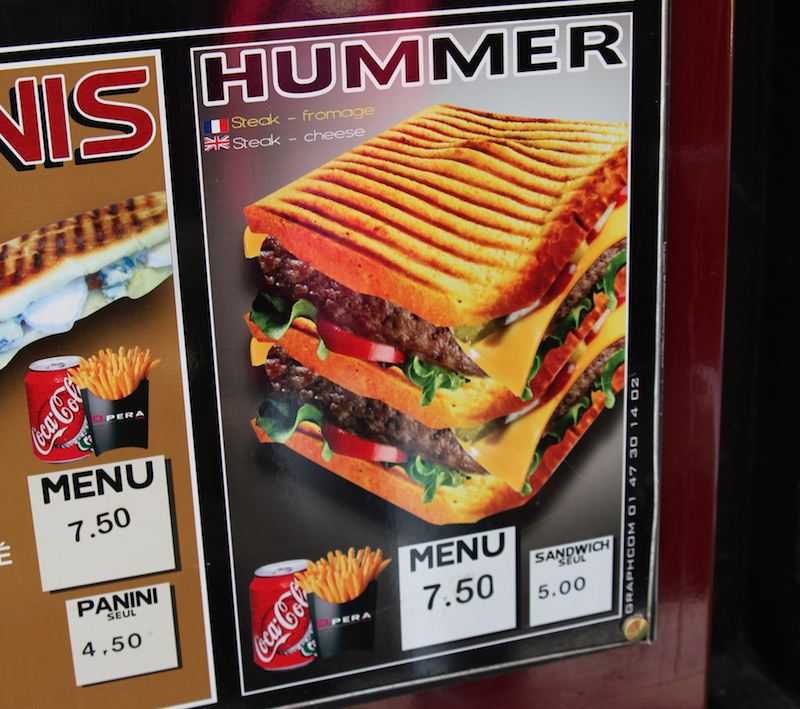
We came across this treat while walking in Paris. The sign over the door said “American Restaurant,” and a visual menu was hung in the window to advertise their offerings (to, I assume, the illiterate). But it was the name that caught my attention first. A sandwich this brazen, this excessive, this laughable could only be named “The Hummer.”
I imagine the classically-trained French chef preparing this meal, weeping. Is this what Americans are thought to enjoy?
What I appreciate most about this image is how un-apologetically it has been manipulated. The identical tomato, cheese, and burger, closely stacked, seem to ask the viewer, “So what?” And the bulge at the top — What is that? What could that possibly be? This American does not want to know.
Posted: August 2nd, 2010 | Author: Devon | Filed under: Italy, Umbria | 4 Comments »
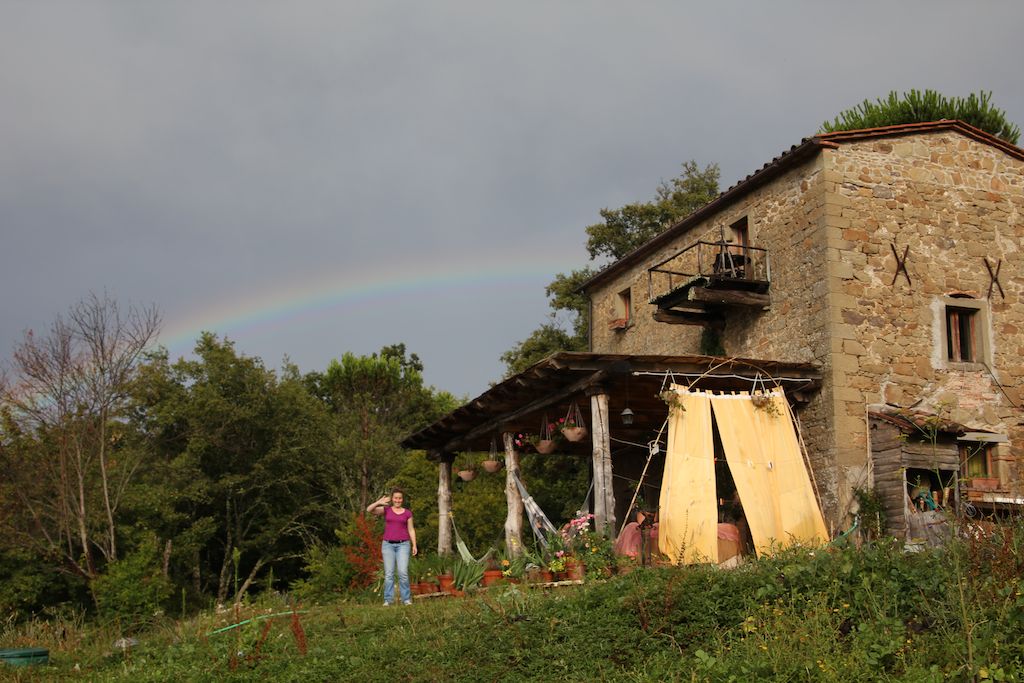
We made it safely to Umbria, and have set up residence with our new host. He lives in a 400 year old home high on hill with a killer view of the farms and other chateaus in the area. Above is a shot taken shortly after we arrived. I’m writing this on the porch shown there, and can hear the church bells from the village in the valley below.
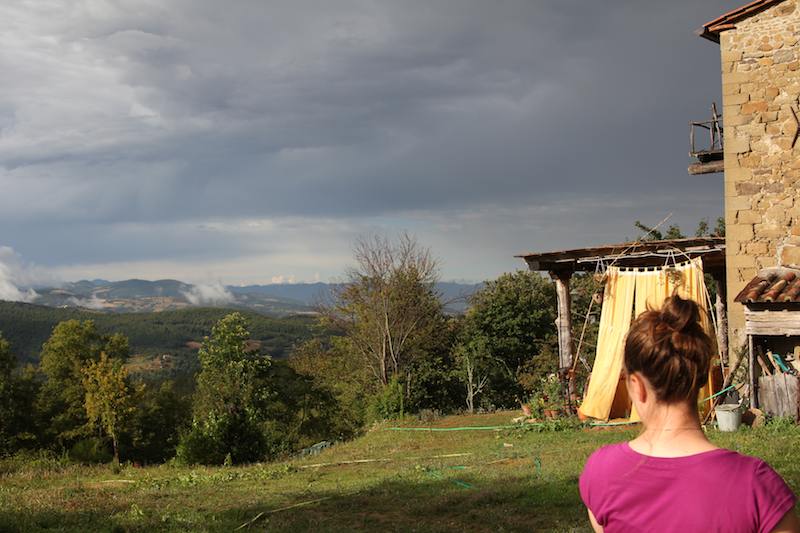
The host is a laid back sort (born in 1951), who did the “hippie trail” (his words) of India back in the 70’s, and now is living a beautiful lifestyle on 5 acres out here. He has a horse, a donkey, a cat, a dog, and three recently acquired ducks.
The work is more standard manual labor stuff. We were clearing brush along a road this morning. We will be building some stone and mortar enclosures for his fruit trees next. We may make a house for the ducks.
Italy has a feel completely unique from France. I would describe it as warmer, more provincial, more run down, but generally more cheerful. People crack jokes with strangers, which I like.
Posted: July 15th, 2010 | Author: Halbe | Filed under: Uncategorized | 3 Comments »
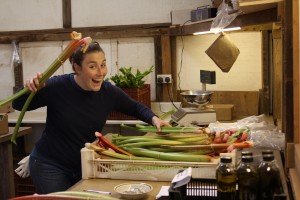
Halbe weighing rhubarb for the box scheme customers in Wales.
On our travels, we’ve heard a few common themes from small producers of organic goods (for ease of writing we’ll call them “farmers”). They don’t like branding and with it, marketing. When Devon and I first heard this at a farm in Wales, we were awe struck. Why wouldn’t they brand their product? If they’re trying to sell what they make, wouldn’t they want as many people to know about them as possible? The answer is a simple, “no.”
At the farm we worked on in Wales, the two owners flat out said they, “didn’t believe in branding.” This coming from two people who live off the income from their farm. They have a box scheme (i.e. they sell boxes of produce to individuals who would pick them up) and went to two farmers markets, weekly. But, they didn’t market their produce beyond that and were even hesitant to use brown paper bags. They feared people might start to associate them with paper bags as a type of branding. This is an extreme example, but many of the farmers we’ve worked with didn’t like branding/marketing either.
We’ve come to a few conclusions as to why this might be. They’re based on direct feedback from the farmers themselves and educated observations we’ve made on our travels. The first is concerned with marketing. They don’t want to work with large grocery stores. Some of the farms we worked with had in fact turned down the opportunity to work with grocery chains (e.g. the farm in Wales). The goat cheese farm we worked at in Cork even severed their partnership with a local chain.
As told by the farmer, the main reason was that they didn’t really make much money working with them. They even lost money. They were selling goats milk – true blue, unpasteurized goats milk. When he first partnered with the store he was thrilled. He’d be able to sell dozens more litres than when he was at the farmers market. Or so he thought. What ended up happening was that he’d give them milk to sell and he’d get money only if the milk sold. In five days time, when the milk expired (it’s very fresh) they’d tell him to pick up what hadn’t sold (which wasn’t much), bring more and they’d even have to decrease the price. So, he’d sold very little milkand it was going to waste. That’s milk he could have used to make cheese which sells for 7 euros/jar.
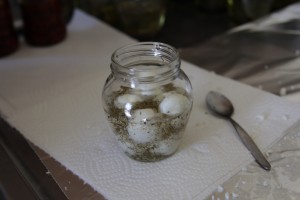
Fresh goat cheese made in Cork - best goat cheese we ever had.
The other reason we thought might play into this is that they prefer to be smaller operations. This way they can control their quality and their work load. They liked being small operations with a few select customers and were perfectly content with the money they made. They loved doing what they did and were pleased just to be making any money from it at all. Expanding was a headache they didn’t want.
What I begin to wonder is what this means for customers who want to eat organic, fresh produce/dairy products but aren’t near a small operation. I understand not wanting to be bigger, but do I need to live in a small town to get fresh eggs, cheese, milk and produce? Not necessarily. There are products at Ralphs that I like, but my point is that it’s not just that the markets don’t work with the farmers, it’s also that the farmers don’t really want to work with the markets.
The issue is complicated and I’m not trying to over-simplify. What I am realizing on this trip is that there are many, many sides to this equation. This one is new to us.
Posted: July 10th, 2010 | Author: Devon | Filed under: France | 3 Comments »
After the sudden change of plans, we made it safe and sound to Chateau d’Isle Marie, in Normandy. It’s a bed and breakfast in a chateau dating from the 11th century. You can read more about it at www.islemarie.com.
One neat thing about the place: There is a graffito on an entrance door frame that reads “EDGAR MASON JUNE 6, 1944”. That’s June 6, as in D-Day. This was a soldier who stormed the beaches that morning, or, possibly, a paratrooper who fell from the sky.
Posted: July 8th, 2010 | Author: Halbe | Filed under: France, Wine | 7 Comments »
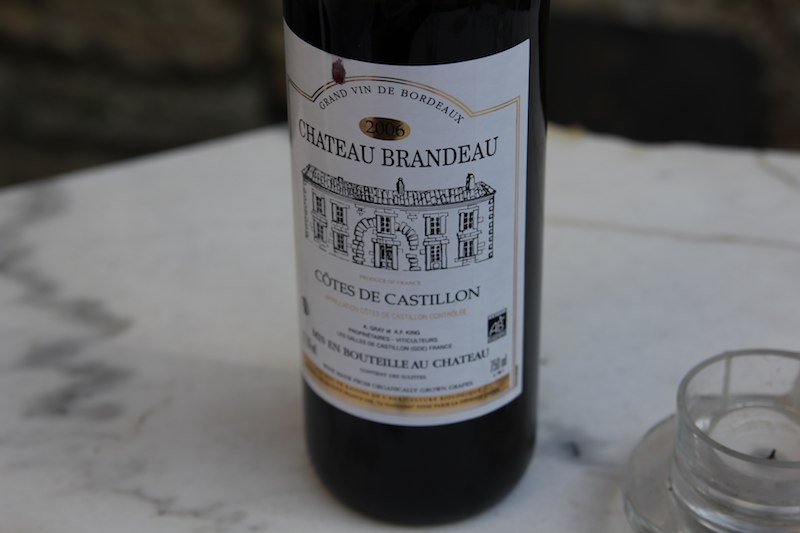
Disclaimer: I speak in generalities in this post. There are exceptions to every rule.
France and California are two of the major wine producers in the world (joined recently by Australia). However, there are some significant differences between the two industries and the wine they produce. We had the pleasure of enjoying a weekend in Bordeaux at their annual Fet la Vin (wine festival) and tasted some amazing wines. But we also learned quite a bit about how CA and French wine differ.
First, the overall feeling toward California wine in France is one of slight disgust. The vintner at our last winery described CA wine as, “fast, sexy and simple.” CA and France grow their grapes and make their wine very differently.
The French wine industry is bathed in tradition. They’ve been making it since the Roman times (read, over 1,000 years). They have a lot of respect for this tradition and it significantly restricts the way wine can be made and grown. The main regulatory body of wine in France is the AOC (L’appellation d’origine contrôlée). They require vines to be grown a certain distance apart. This spurs competition between the vines. They also don’t allow France to irrigate their vines. The reason for this is not only that the French believe the vines need to “suffer;” they also want their wine to reflect the weather of that year, to make it unique. If there’s a dry year their grapes will differ from a wet year.
In France, they always put the year of wine on the bottle, called the “vintage.” One year from the next can be drastically different. They additionally tend to mix grapes and many regions will grow the same grapes. So, if you have a bottle of red wine from Bordeaux there is a 99% chance they used merlot and cabernet franc. If you have a white wine from Bordeaux, they’ve used sauvignon blanc and semillon. Sometimes they list this on the bottle, but generally, they expect you to just “know” this.
As I’ve mentioned, the vintage is important to the vintner. They list the year which will likely tell a local if it’s a good bottle or not – 2005 was a dry year so the wine isn’t as good while 2006 was a year a lot of sun and just enough rain so it’s a better year, etc. Not easy if you’re not a local. So, in this vain, they do not mix their vintages. And if they do, they can’t put the year on the bottle, which is a hallmark of the French wine industry.
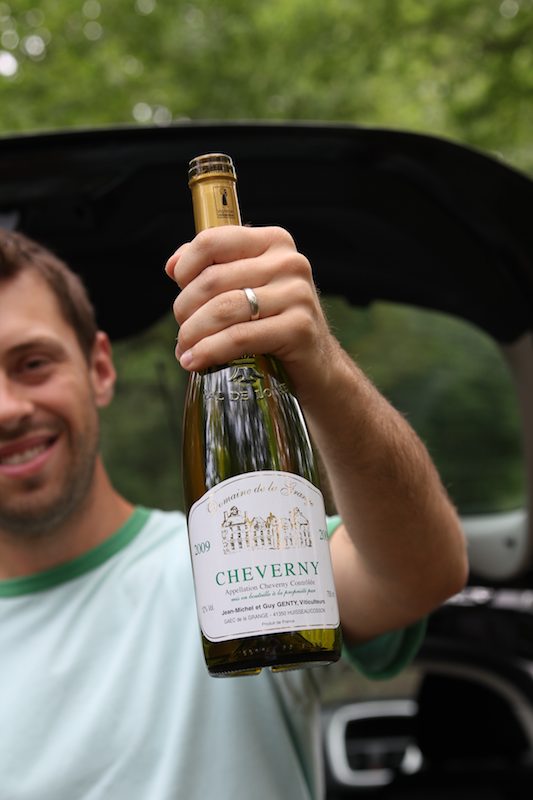
Lastly, the average winery in France is approximately 10 hectares (24.7 acres). The the most expensive wineries in France will even grow just 3-4 hectares to minimize the number of bottles they produce which affects their price. In Saint Emillon, the most expensive region of wines in France, they usually only produce 3 hectares of grapes and produce 10,000 bottles each year making their wine all the more in demand and harder to find. They sometimes go for over $1,000.
All this said, California does the opposite in most scenarios.
In California, their wineries are hundreds of acres. They also water their vines in addition to putting heaters around them, adding nitrogen to their soil and well, babying the heck out of them (pssst, some French wineries do this too). Their vines are essentially the same each year to make their wine consistent. Consistency is one of the major differences between French and Californian wines. The French snub their noses to this concept. Consistency? How is that interesting?” they say.
To make Californian wine consistent, the wineries will mix vintages. This difference is appalling to the French who look down on mixing years. But in California, to make their wine generally taste the same each year, they’ll, for example, mix a little of 2005 with 2009 to make sure it has that same clean, crisp chardonnay taste their customers count on.
They also tend to use a single grape variety like chardonnay or merlot. Now, there are of course exceptions, but when you buy a CA wine, it usually will say chardonnay or merlot on the label. That’s because they use just that grape, or the vast majority of the wine is made with that grape.
Although some CA wineries will label their vintage on the bottle, a bottle of 2005 chardonnay from one winery will taste almost exactly the same as the bottle of 2008 from the same winery. I was talking to one of the other Helpx’ers at the last winery, and when we were talking about this very subject she had a great example. She said she had been buying chardonnay from the same winery for years. It was consistently the same taste she’d counted on from a 2003 to a 2005 to a 2009. It didn’t matter the year, it was always the same wine. CA is known for this reliability to their customers and the French just don’t understand. In their mind, the different vintages should taste different.
The last difference I’m finding is one of personal taste. For those who know me fairly well, I don’t like red wine very much. At least, I used to not like it. I’m finding that the reds in Bordeaux are wonderful and I like them very much. They don’t have the bold strong flavor California reds are known for. The French call it “simple.” Whatever it is, it’s not my taste so when I go back to Cali, I’ll be buying my reds from the French.
I’m actually really excited to go wine tasting in California again with my new found knowledge of wine. It’ll make it more interesting. Oh, and it gives me another reason to drink a lot of wine!
Posted: July 7th, 2010 | Author: Halbe | Filed under: France | 6 Comments »
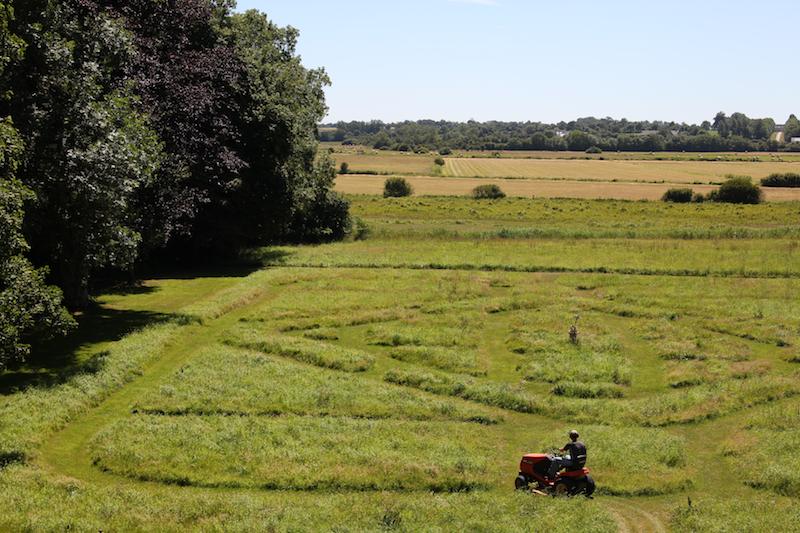
That is all.
Posted: July 4th, 2010 | Author: Devon | Filed under: France, Unexpected Adventure | 6 Comments »
Halbe and I were in a rented car on Saturday, finishing a three-day road trip through the Loir Valley. The plan was to drive to Caen, spend the night, return the car, then on Sunday be picked up to begin a three week stay in a beautiful cider farm in Normandy.
We’re a few hours outside Caen when we receive a mysterious text message from our host at the cider farm, something about “sorry it didn’t work out” and could he help find “someplace more hospitable.” We get our host on the phone, who tells us there was a “miscommunication” and that he did not believe we were actually confirmed. In addition, his father had recently passed away and this was not a good time to come. The whole thing didn’t sit quite right with us, as we had confirmed our stay with him via email a month or so previous. But, what can you do? The man said no.
The cost of a hotel/hostel in France for three weeks would cripple us financially. We took him up on his offer to help find another place. More calls are exchanged, us drawing closer to Caen by the moment. The now non-host connects us to his neighbor who needed help with their curtains. As in, making and hanging curtains, possibly for three weeks. We weren’t sure.
And then we received a call from a cheerful woman named Dorothea. She had been expecting a helper for her B&B but fell through, and was “keen” to find a replacement. It’s a little further down the road, she said, but she could pick us up. She said the main house was full, but we could stay in the farmhouse, and she could take us all three weeks. She gave us her web site to check once we arrived in Caen. We said we’d let her know.
We get to Caen, get a hotel, and load up her site. Here’s the place:
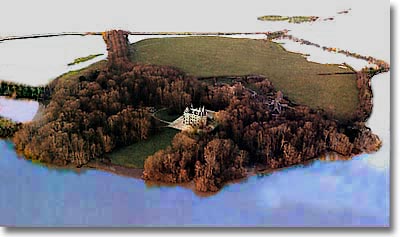
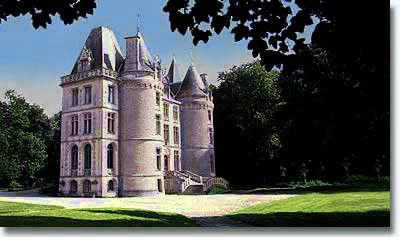
Wow. Alright, looks great. But what about that farmhouse?
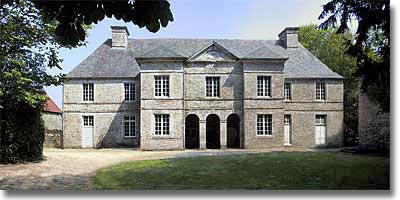
We were sold. We called her back and set up a time to meet later today (Sunday). So, goodbye cider farm, hello magical island in Normandy. We really hope it works out.
And to everyone in the States, happy Fourth of July!
Posted: June 30th, 2010 | Author: Devon | Filed under: Bordeaux, France, Wine | 4 Comments »
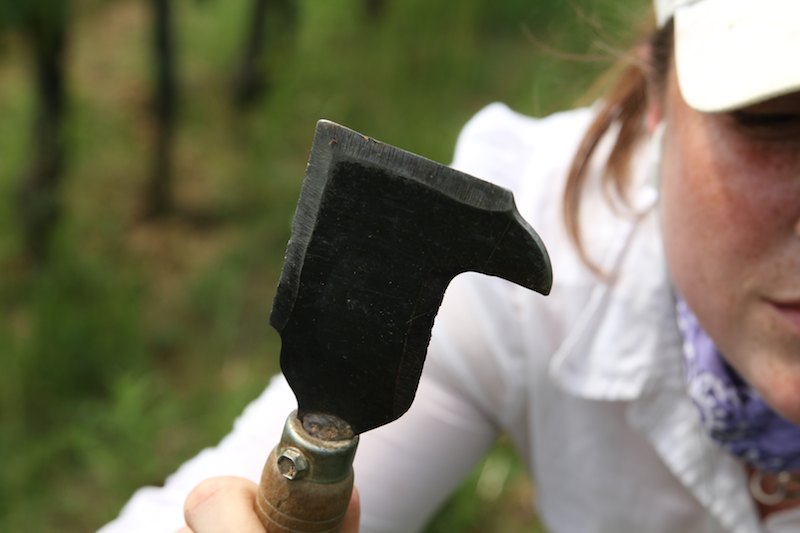
You’d think grape vines would have it easy. The way wine is cooed over by the cultured and wealthy, and labored over by millions of dedicated vintners, then surely their lives must be nothing but sunshine and gentle care, right?
Allow me to introduce a vine knife, held by my lovely wife Halbe. This nasty, hooked blade is one of several torture devices we’ve employed since arriving at our current host. With it we hack and carve the plants, and for what? The idea is this: happy vines make no fruit. Vines beaten to the limit of their survival produce offspring (that’s grapes to us) as quickly as possible.
We start young. Three-year-olds, dude. By now they have decent roots (American, of course) and have grown six to eight long, green vines. They reach out to the sky, flopping in the air like the arms of laughing children. Not acceptable. We spent five days removing these vines from 7,000 baby plants. Halbe preferred the knife, but I just ripped them out with my bare hands. We leave two vines on each, and truss them up with plastic cord, holding them vertical.
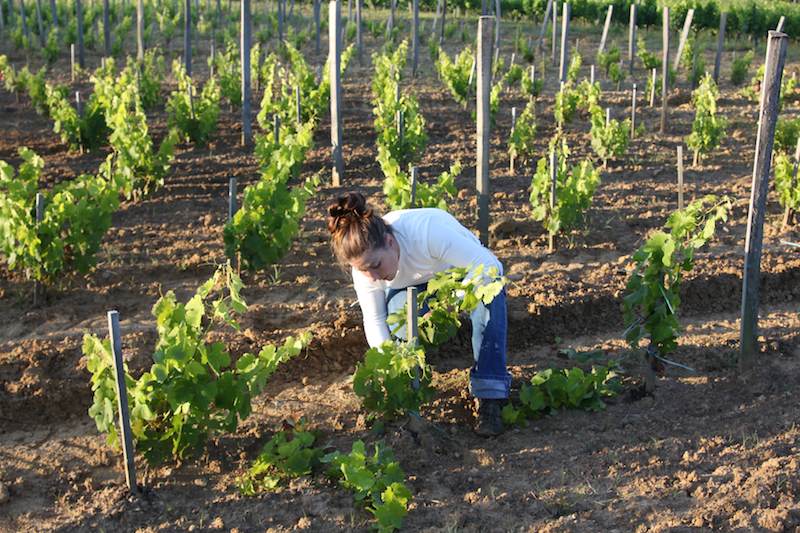
The babies, they don't understand
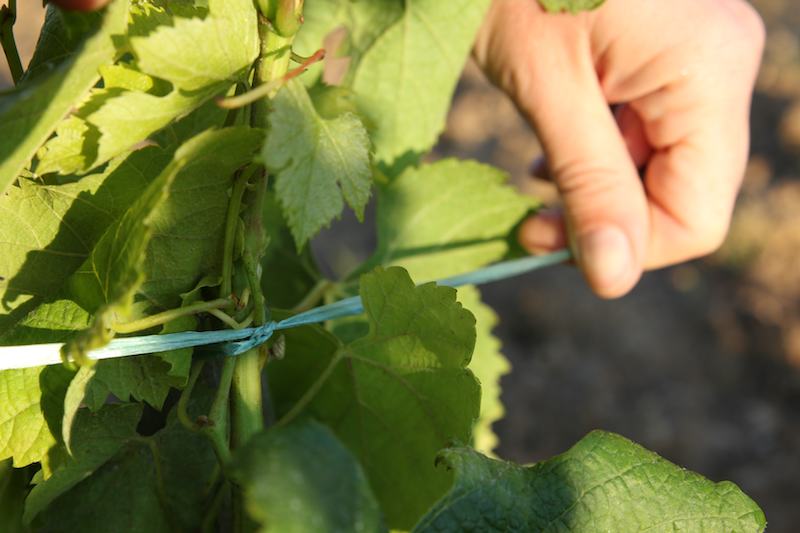
Now, with less vines to support, the roots pump all their goodness into those two remaining, vertically-tied vines, forcing the plant to grow to a better height for picking and further abuse/tending.
Épamprage (eh-pahm-prajsh) comes next. The plants get bigger and eventually produce grapes. They also continue to attempt new vines, from the graft point, from the stalk, and from the head. We hack those off. On some farms, they have a machine to do this. It smacks the vines with strips of rubber tire until those suckers rip off.
What else? Oh yes, if they get too tall, they chop off the tops. You’re not allowed to water them. And, as if to add insult to injury, when they DO grow grapes, some farms do a vert vandage — green harvest — and remove about a third of the immature grapes and throw them away.
It’s a hard knock life, absolutely, but without it, we’d have no wine. Generally speaking, the harder those vines have to work to grow those grapes, the higher the quality of grape and the finer the wine. But not too much pain. After all, a vintner depends on those vines for their own survival.
Posted: June 28th, 2010 | Author: Devon | Filed under: Bordeaux, France | No Comments »
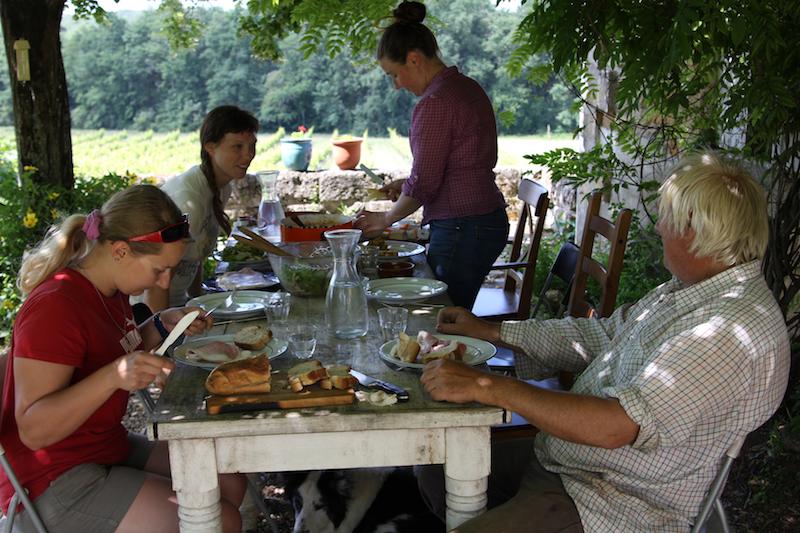
Same table, some different people, different day
I’m sitting at a table in Castillon la Battaille, France, with my wife and two other women. Both are from the United States and both have blogs about traveling in Europe, much like this one. So here we sit, thousands of miles from home, discussing our blogs that we write for the people we know, thousands of miles away.
Their blogs are:
Jenny (in the photo above, back left, white shirt): Moving & Eating
Jenny is into cheese and like us has worked on goat farms. She lives not far from us in SoCal, and has a job very similar to Halbe’s. Today as we tended the vines, she told me about one of the only film ever shot in the constructed language Esperanto, Incubus, starring William Shatner.
Elena (not pictured): Passport? Check!
Elena arrived yesterday to the farm. She grew up in Olympia, Washington, a short drive from where I went to university in Seattle. This evening we did the dishes, and discussed our shared love of Dick’s Hamburgers.
These coincidences are odd and ongoing. Do people in their twenties from the West Coast just particularly like to travel and work on farms?
Posted: June 28th, 2010 | Author: Devon | Filed under: Bordeaux, France, Wine | 4 Comments »
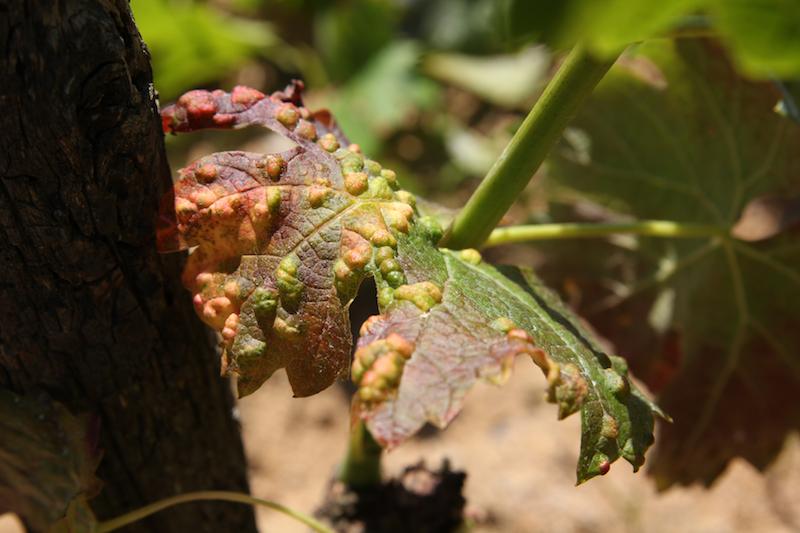
All French wine is from grapes grown on American roots. From the thousand dollar bottle on down to the swill, a little bit of the US of A is in every sip. Here’s why:
In the 1860’s nearly half the vineyards in France had fallen to a terrible blight. Vines, many of them decades old, were faltering, not producing grapes, then eventually dying. No one knew why. The blight lasted for over 15 years, closed over 4 million wineries, and devastated the French economy. The government offered a reward of 320,000 francs to anyone who could cure the problem.
A team of French biologists figured out the cause in 1870: an aphid, introduced from America, called phylloxera. This tiny insect would nest in the leaves (like the one I photographed above), hatch, fall to the ground, and consume the roots of the grape vine, eventually killing the plant.
Knowing the cause was a help, but there was no cure. Farmers tried pesticides and other chemicals. They left frogs under the plants, and let chickens roam the vines with the hope that they would eat the phylloxera. None of these ideas worked. It was Leo Laliman and Gaston Bazille, a team of previously unknown wine growers and viticulturists, who suggested the solution of grafting America’s phylloxera-resistant rootstock on to French vines. Their solution worked, and over the following years there was a great reconstruction of the wineries and their vines, and eventually the wine industry returned to normal.
No cure to phylloxera has been found, and this practice continues today. Every vine I’ve worked on or seen since arriving to France has a graft point near the base. The young vines still have a covering of wax over their graft point, like this:
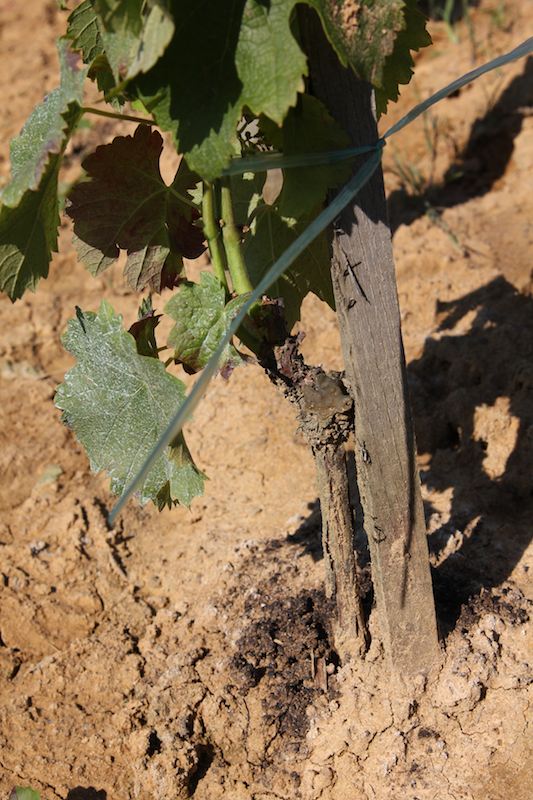
That bark covered stick is a chunk of harvested American rootstock. An inch-long portion of a French vine was grafted on top, and has since grown into several new, green vines. Though the plant will likely contract phylloxera (many vines have diseased leaves like those in the top photo), the plant will remain strong and hopefully produce grapes for decades to come. That American rootstock will also attempt to grow vines, and their removal is one of the common chores on all wineries. In fact, that’s what I spent most of this morning doing with a spade and pruning shears.
As for Leo and Gaston, they did not receive the 320,000 reward. The French government argued they had not cured the blight, but only stopped it from occurring.
















